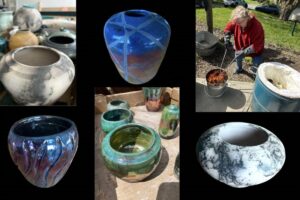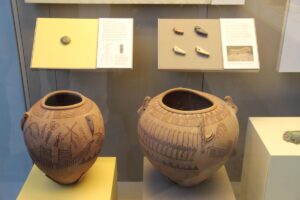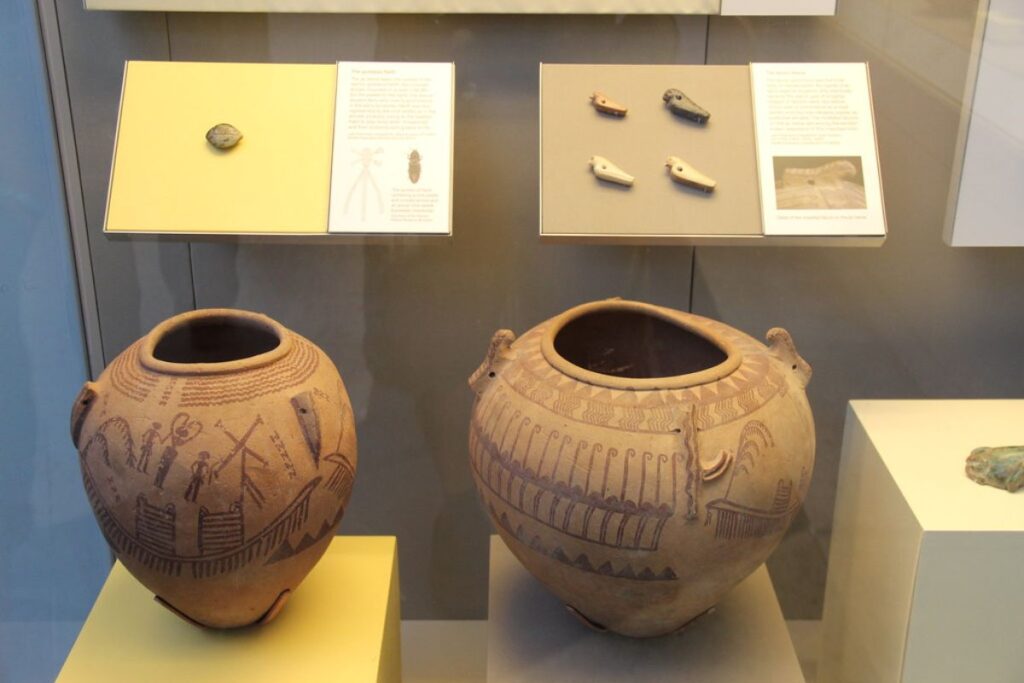
Growing up, I was fascinated by ancient civilizations. History channels like “Discovery” and “National Geographic” were my go-to on television. There, ancient Egyptian history shook me to my core. I watched for hours on end about their culture, beliefs, architecture, etc.
Among all the big, noticeable monuments, pottery was the one consistent aspect. They looked very unassuming at first glance, they seemed ordinary—brownish, chipped, and silent. But as I read the descriptions and examined the brushstrokes and shapes, something shifted. These weren’t just containers; they were messages in clay, whispering stories from kitchens, tombs, and temples thousands of years old.
That day sparked a lifelong curiosity: “How could something as humble as pottery reflect the evolution of an entire civilization?”.
These vessels were not just mere everyday tools, but they were ceremonial pieces that held offerings to the gods, prized pieces that turned the tides of trade negotiations. They were the most practical ways to transport goods across the Nile River.
Today, I’ll tell you all about the hidden stories of this ancient craft. How they shaped history, and evolved through the centuries, and the legacy they carry to this day.
Table of Contents
Predynastic Period (c. 5000–3100 BCE)
Egypt is one of the oldest prehistoric human settlements. Before the emergence of pharaohs and pyramids, Egypt was home to a series of Neolithic cultures that laid the foundations for its future greatness.
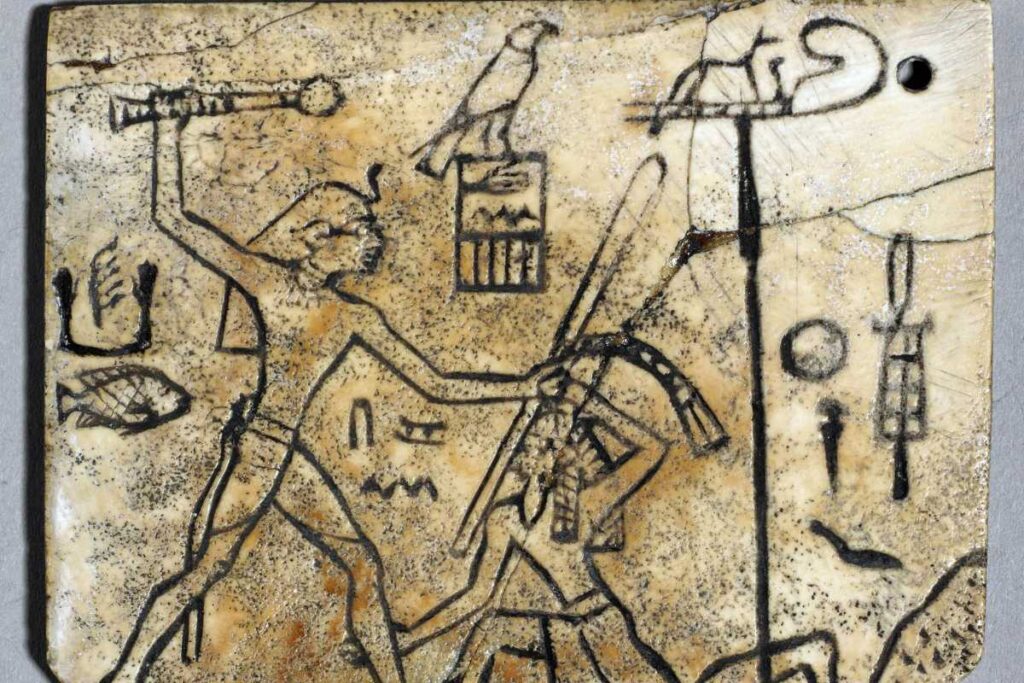
Not all of them are sadly available for us to examine, meaning the loss of thousands of years of history. However, Pottery from the Predynastic Period, particularly the Naqada I to III phases (also known as the Amratian, Gerzean, and Semainean), displays an incredible range of creativity and regional variation.
Let’s dive in.
Naqada I–III (Amratian, Gerzean, Semainean cultures)
The Naqada culture represents a history of a millennium. This is an essential archaeological site to understand prehistoric Egypt the best.
Naqada I:
This era was marked by its bold black and red color scheme. Potters used Nile silt clay to create black-topped redware, a hallmark of the era. These vessels were shaped by hand, using coiling or pinching methods, and then burnished to a high shine. The unique black tops were achieved through a reduction-oxidation firing technique that limited oxygen exposure to the rim.
This pottery was mostly used for food storage and ritualistic usage. Different patterns, along with animal motifs, were drawn on them. These patterns were descriptive enough for historians to determine their use cases.
Naqada II:
In Naqada II, decorative complexity increased. Potters introduced painted motifs using white or red slips, depicting boats, animals, hunting scenes, and geometric patterns. These motifs likely held symbolic or religious meanings, as many vessels were found in graves alongside the deceased.
These pieces were largely for ceremonial and decorative purposes. Their placements in archeological sites explain their significance in society at the time.
Naqada III:
By Naqada III, pottery production became more standardized, reflecting growing political centralization.
Other early regional styles, such as Fayum and Badarian wares, also contributed to the broader Predynastic ceramic tradition. The Badarian culture, in particular, is known for its finely made red-polished bowls with blackened rims. Pottery from this period was often included in burials, reinforcing a belief in provisioning the dead for an afterlife.
Cultural significance:
Naqada culture set the foundation for future generations to roam the Nile plains. These clay vessels started as a convenient tool for storage and transportation but evolved into much more. The Naqada people started decorating them with different motifs increasing their value in monetary and spiritual ways. These clay pots spanned from household utensils to funerary contexts.
Early Dynastic and Old Kingdom (c. 3100–2181 BCE)
Ancient Egyptian pottery went through a revolution after the reunification of Egypt. However, the core concept remained the same. Its cultural impact rose by magnitudes as more people came to practice similar traditions.

This period also marked the emergence of state workshops. These controlled production centers ensured standardization and a consistent pottery supply for temples, palaces, and burial complexes. Pottery became both a product of artistic skill and a symbol of growing state organization.
Technological advances:
This era saw the introduction of marl clay, a pale, durable material ideal for elegant forms. Potters also began using the wheel, allowing for greater symmetry and efficiency in shaping vessels.
Not only that, but newer more advanced techniques such as kilns and wheels began emerging. These truly gave a boost in manufacturing whilst giving more time for artistic liberties.
Stylistic traits:
Stylistically, pottery during this period was functional and relatively plain. Decoration gave way to form and practicality. Cylinder jars and beer jars were prevalent, especially in tombs, where they served as offerings for the afterlife. The prominence of these vessels underscores their strong religious and funerary role.
Functionality:
This era saw a great deal of innovation in pottery. More stylized pieces began to show up in gatherings.
However, their functionality remained pretty much the same. They stayed bound to storage and funerary uses.
Cylinder jars and beer jars were prevalent, especially in tombs, where they served as offerings for the afterlife. The prominence of these vessels underscores their strong religious and funerary role.
Middle Kingdom (c. 2055–1650 BCE)
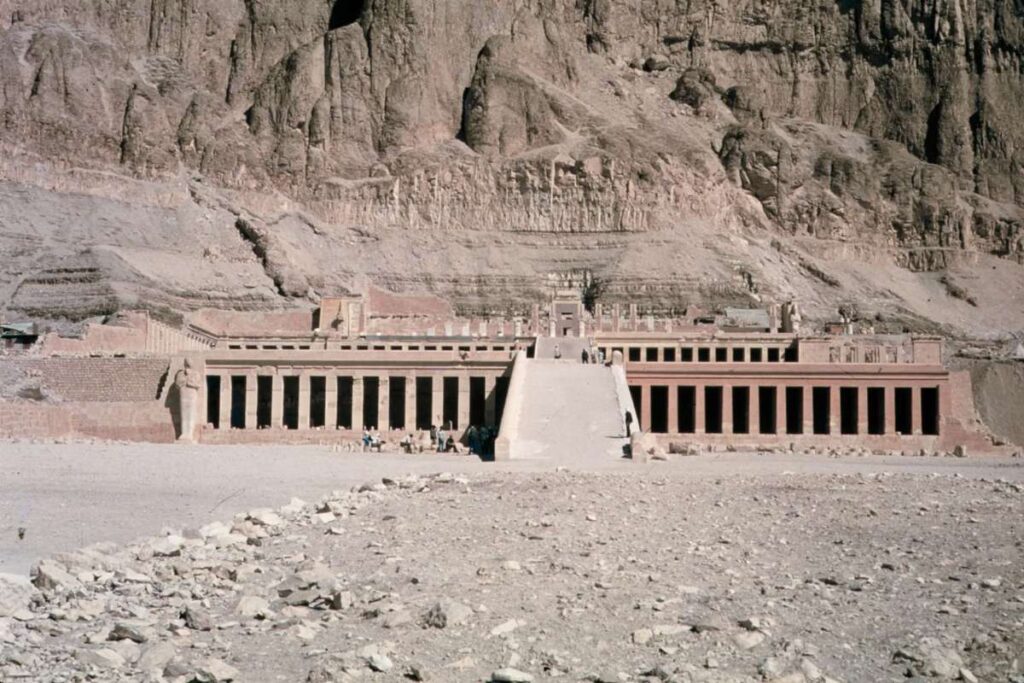
During the Middle Kingdom, Egyptian pottery underwent a revolution. Political stability led to the standardization and mass production of pottery. Changes in clay, firing techniques, and decoration were so noticeable that archeologists were able to identify them thousands of years later.
Here’s a more detailed outlook on the Middle Kingdom Egyptian pottery:
Standardization and mass production:
Advances in kiln technology and the widespread use of the potter’s wheel allowed for uniform and efficient production of pottery in large workshops. Standardized vessels were used for everyday storage, religious rituals, and funerary practices. Pottery also played a key role in administration, with seal impressions marking ownership and origin for trade and distribution.
Common styles:
Red-polished ware became especially popular, characterized by a smooth finish and rich hue. Another hallmark was the black-rimmed bowl—a form both elegant and utilitarian. Tall jars with slender necks and rounded shoulders also featured prominently. Decorative slips and banding grew more refined, lending these vessels an understated sophistication.
Pottery in society:
These ceramics were everywhere. They were used in domestic life, religious rituals, and burials, serving as a bridge between the sacred and the everyday. Many pottery forms began to mimic metal vessels, indicating either aesthetic aspiration or symbolic equivalence.
New Kingdom (c. 1550–1069 BCE) – The Golden Age
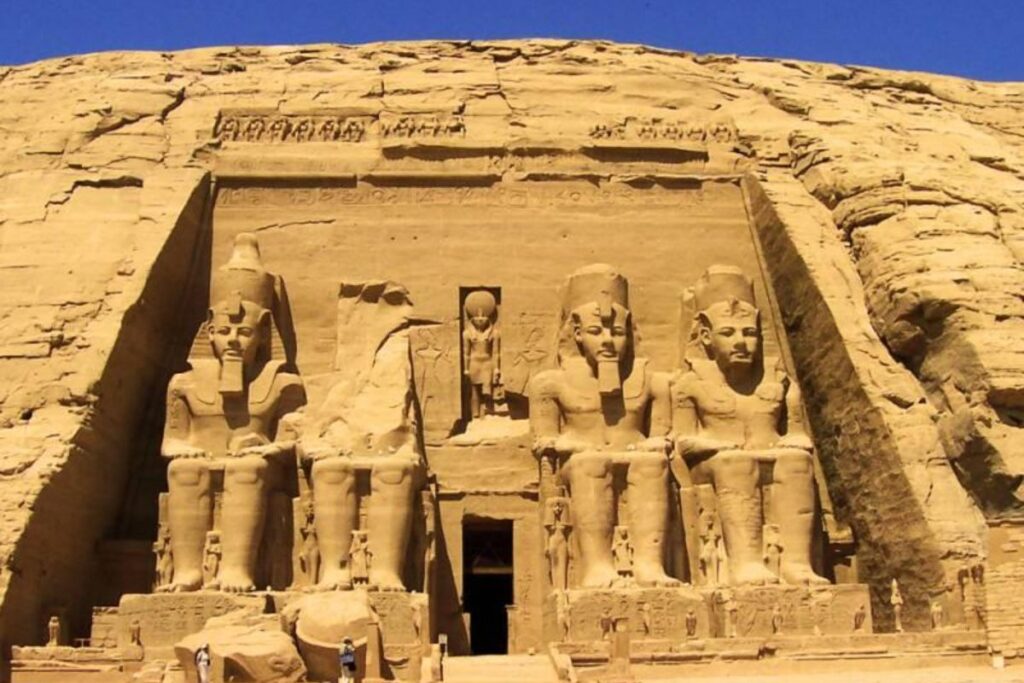
The New Kingdom truly was the golden era of ancient Egypt. Pottery in New Kingdom Egypt transcended beyond just utilitarian or ceremonial vessels. They saw significant advancements in both craftsmanship and style. During this period, pottery was highly varied, serving both practical and decorative purposes. The use of the potter’s wheel became even more widespread, allowing for more precise and consistent shapes.
Let’s take a closer look:
Explosion of artistic variety:
The New Kingdom marked the height of Egyptian power and creativity, and pottery blossomed alongside other art forms.
Fineware with painted motifs—lotus flowers, papyrus stems, and divine imagery—became widespread. This era also bore the influence of Atenism during the Amarna period under Akhenaten, with pottery styles reflecting the religious revolution. Tomb paintings show scenes of pottery production, emphasizing its cultural and ritual importance.
Pottery during this era moved beyond practicality. It became a canvas for religious expression, a marker of social status, and a testament to the craftsmen’s ingenuity.
Technological mastery:
Technological mastery was evident in the advanced use of potter’s wheels and well-regulated kilns, allowing precise control of temperature and color. A standout innovation was faience: a glazed non-clay ceramic that shimmered in vibrant turquoise and cobalt blue. It was used for ritual objects and luxury items, valued for both beauty and symbolic resonance.
Social and economic reflections:
The intricate decorations on the pots signify the growth of the Egyptian economy at the time. The unusually shaped vessels, clearly for artistic purposes, show the luxury aspect of pottery.
Pottery became significant in decor, burial vessels, and art. That said, it was still the primary tool for storage and transportation. Safe to say, pottery was the jack of all trades at the time.
Late Period and Greco-Roman Era (c. 664 BCE – 395 CE)
During the Late Period (664–332 BCE) and Greco-Roman era (332 BCE – 395 CE) of Egypt, pottery evolved significantly while still serving practical and religious functions.
In the Late Period, pottery became simpler, with traditional Egyptian designs continuing but influenced by foreign cultures, especially from the Near East, due to Persian rule. Foreign influences were clear with many of the styles from other reigning cultures being redefined with Egyptian motifs consisting of gods, humans, animals, etc.
Increased foreign influence:
As Egypt came under foreign dominion, first by the Assyrians and Persians, and later by the Greeks and Romans, its pottery began to absorb new stylistic elements. Greek forms such as amphorae and kraters were reimagined with Egyptian decorative themes, creating hybrid styles unique to this period.
With the Greek conquest of Egypt and the rise of the Ptolemies, followed by Roman rule, pottery styles saw greater foreign influence. Greek and Roman designs introduced molded amphorae for transporting liquids, and mass-produced utilitarian pottery became more common.
Decline and transition:
Fine-painted pottery declined, but traditional Egyptian pottery, particularly for funerary and religious purposes, persisted, blending Greek and Egyptian motifs. Pottery also became a key export item, with Egypt trading amphorae and other vessels across the Mediterranean.
Mass production intensified, particularly for temple use and trade. Molds and stamps became standard, facilitating the rapid creation of vessels for widespread distribution. Artistic individuality declined somewhat, replaced by efficient, repeatable designs.
Funerary practices:
In funerary contexts, pottery played a major role. However, they evolved by leaps and bounds in this era. With advanced techniques and styles, pottery played a crucial role during this era’s burial practices.
Canopic jars held organs for the afterlife; Shabtis (servant figurines) and painted amphorae became common grave goods. Bilingual inscriptions in Greek and Demotic script further illustrate Egypt’s cosmopolitan character during this time.
Techniques and Materials Across Eras
Ancient Egyptian Pottery evolved with the eras. It varied widely in design, techniques, and motivation. Dramatic shapes came from other cultures and were redefined with Egyptian themes, changing the rigid thematic ideas prevalent before.
Clays:
| Eras | Clay type and use |
| Early Dynastic and Old Kingdom | Primarily Nile slit clay, Marl clay for finer vessels |
| Middle Kingdom | Mostly Marl clay |
| New Kingdom | Marl clay, introducing faience as non-clay ceramic |
| Late Period and Greco-Roman Era | Nile Slit clay, Faience |
Forming methods:
| Eras | Techniques |
| Early Dynastic and Old Kingdom | Primarily Hand-coiling, the Potter Wheel adopted |
| Middle Kingdom | Potters Wheel |
| New Kingdom | Advanced Wheels for more intricate shapes |
| Late Period and Greco-Roman Era | Molds and Wheels |
Firing:
| Eras | Technologies |
| Early Dynastic and Old Kingdom | Open-pit firing |
| Middle Kingdom | Simple kilns |
| New Kingdom | Advanced kilns |
| Late Period and Greco-Roman Era | More Sophisticated kilns capable of mass production |
Decorative techniques:
| Eras | Methods |
| Early Dynastic and Old Kingdom | Emphasis on form, minimal decor |
| Middle Kingdom | Slips,red-polished finish, black rims |
| New Kingdom | Painted Floral, and religious motifs, glazing |
| Late Period and Greco-Roman Era | Stamps, molds, painted amphorae, foreign motifs |
Pottery as a Window into Ancient Life
Ancient Egyptian pottery is truly a window to the times of these vessels were created. Whenever I look at them, I can clearly imagine their lives, their cultures, and their superstitions.
From the utilitarian to the symbolic, these ceramic vessels were integral to every sphere of activity. By the shapes and builds, archaeologists have determined their uses.
Here is what we know about different uses of Egyptian pottery so far;
Daily life and diet:
Egyptian ceramics were a significant part of the preparation, storage, and transportation of basic food and drink items.
They were used for cooking, storing grains and liquids, and even for brewing beer and baking bread—staples of the Egyptian diet. Their shapes and wear patterns offer clues to food preparation and consumption.
Trade and economy:
Economically, pottery also played a crucial role in trade. Imported wares found in archaeological sites reveal connections with other cultures, indicating Egypt’s involvement in a broader exchange network.
Pottery also served as a medium for communication. Ostraca (potsherds used for writing) have preserved shopping lists, school exercises, and even personal letters.
Religious and symbolic use:
Spiritually, ceramics held deep meaning. In tombs, they were placed as grave goods to nourish the deceased in the afterlife or to serve ritual purposes. Some vessels bore inscriptions or symbolic motifs believed to hold protective powers.
Religious/ Ceremonial usage was the biggest part of ancient Egyptian pottery at pretty much any point in history. Even when they weren’t, these ceramics still had religious symbols as motifs in the vessels.
Legacy and Modern Impact
The legacy left behind by the Ancient Egyptian pottery is truly astounding. Their beauty truly transcends time and still influences artists of all mediums.
Museums and auction houses jump at the chance to get their hands on a piece of ceramic from the different timelines of ancient Egypt.
Today, the legacy of ancient Egyptian pottery endures in both scholarship and popular culture. Even beyond academia, Egyptian pottery continues to influence modern ceramic design. Its forms, colors, and motifs are echoed in contemporary artworks and decorative crafts.
Preservation and study:
Today, the legacy of ancient Egyptian pottery endures in both scholarship and popular culture. Archaeologists rely heavily on ceramic fragments to date sites and interpret ancient lifeways. Technological advances such as X-ray fluorescence (XRF) and 3D scanning allow researchers to analyze composition and reconstruct broken artifacts with remarkable accuracy.
Museum collections and public fascination:
Museums around the world dedicate entire exhibitions to Egyptian ceramics, captivating audiences and educating them on a civilization that still resonates today.
Collectors across the globe rave about these ceramics. These are prized items for their beauty and history.
Conclusion
Ancient Egyptian pottery is an evolution across millennia that mirrors the changing heart of Egypt itself—resilient, innovative, and eternally bound to the clay of its sacred land.
The awe I felt seeing those vessels for the first time on National Geographic still echoes in me. It reminds me that something shaped by hands thousands of years ago can still stir something deep within us. Egyptian pottery is not just history—it’s a heartbeat, preserved in clay.
This craft is a storyteller of times that are long gone. Each brush stroke, and crack from the kilns show the history evolving and revolving around the pottery. It’s like an organism that is alive and whispers the ancient life in person.
You should also try learning about them more and seeing the wonders in person by visiting your local collection houses or museums. This will strike creative inspiration and evoke strong emotions from within.
Frequently Asked Questions
Why is ancient Egyptian pottery important?
Ancient Egyptian pottery offers a valuable window into the past. Through its forms, decorations, and materials, historians and archaeologists gain insights into daily life, religious practices, and even technological developments of the time. The presence of different vessel types shows how Egyptians stored food, prepared offerings, and conducted rituals, reflecting both the practical and symbolic aspects of their society.
What materials were used in Egyptian pottery?
The Egyptians primarily used two types of clay: Nile silt clay, which is rich, dark, and widely available from the riverbanks, and marl clay, a lighter, limestone-based clay found in the desert regions. Each had specific uses based on its texture and firing properties. Later in their history, Egyptians also developed faience, a non-clay material made from ground quartz, known for its glossy, colorful glaze.
Was pottery only used by the wealthy?
Not at all. Pottery was a universal part of life in ancient Egypt, used by all social classes. While the elite might have had more elaborately decorated or finely crafted vessels, everyday pottery served essential functions for everyone, from cooking and storage to funerary rites and religious ceremonies. Its widespread use makes it a key artifact type for understanding the full social spectrum of ancient Egyptian life.
What is faience?
Faience is a non-clay ceramic material made from powdered quartz and coated with a bright, often turquoise or blue-green glaze. It wasn’t used for typical vessels but rather for decorative items, jewelry, amulets, and ritual objects. Faience held symbolic meaning as well, often associated with life, rebirth, and protection. Its vibrant color and reflective surface were believed to have magical properties.
How do archaeologists use pottery today?
Pottery is one of the most durable and informative materials found at archaeological sites. Experts analyze shapes, decorations, materials, and manufacturing techniques to date layers of occupation, understand trade connections, and reconstruct how people lived. In Egypt, pottery helps identify cultural shifts, influences from other regions, and changes in religious or domestic practices over time.

Hi,
I’m Mashrafe, an experienced writer specializing in writing compelling marketing copies, blogs, product reviews, and guides. I have a knack for crafting engaging articles across a wide variety of topics that are designed to grab attention and drive results. Whether it’s the latest gadgets, beauty products, or niche industry services, I bring a unique perspective that is as interesting as it is informative. So buckle up as I guide you through the world of new trends and tech innovations that will blow your mind.


